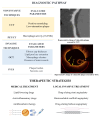Perspectives in the Diagnosis, Clinical Impact, and Management of the Vulnerable Plaque
- PMID: 40095464
- PMCID: PMC11899957
- DOI: 10.3390/jcm14051539
Perspectives in the Diagnosis, Clinical Impact, and Management of the Vulnerable Plaque
Abstract
Coronary artery disease is a highly prevalent disease that constitutes the leading cause of mortality worldwide. Acute coronary syndromes are the most devastating form of presentation of coronary disease, involving the acute formation of a thrombus within the coronary vessel lumen, further leading to flow limitation and diminished myocardial perfusion. Vulnerable plaques, which are characterized by thin-cap fibroatheroma, a large lipid pool, and macrophage infiltration and spotty calcification of the cap, pose a higher risk of coronary events despite not being flow-limiting. Iterations in intravascular imaging and coronary computed tomography have largely increased the ability to detect and define vulnerable plaques, and its clinical impact in early- and mid-term outcomes has been confirmed in several studies. In this review, we aimed to revise the current concept of vulnerable coronary plaque and its repercussion, to summarize the main pharmacological approaches for its management, and to provide an updated overview of the available evidence on preventive percutaneous interventional strategies in this clinical setting.
Keywords: coronary artery disease; percutaneous coronary intervention; vulnerable plaque.
Conflict of interest statement
The authors declare no conflict of interest.
Figures



References
-
- Riley R.F., Patel M.P., Abbott J.D., Bangalore S., Brilakis E.S., Croce K.J., Doshi D., Kaul P., Kearney K.E., Kerrigan J.L., et al. SCAI Expert Consensus Statement on the Management of Calcified Coronary Lesions. J. Soc. Cardiovasc. Angiogr. Interv. 2024;3:101259. doi: 10.1016/j.jscai.2023.101259. - DOI - PMC - PubMed
Publication types
LinkOut - more resources
Full Text Sources
Miscellaneous

